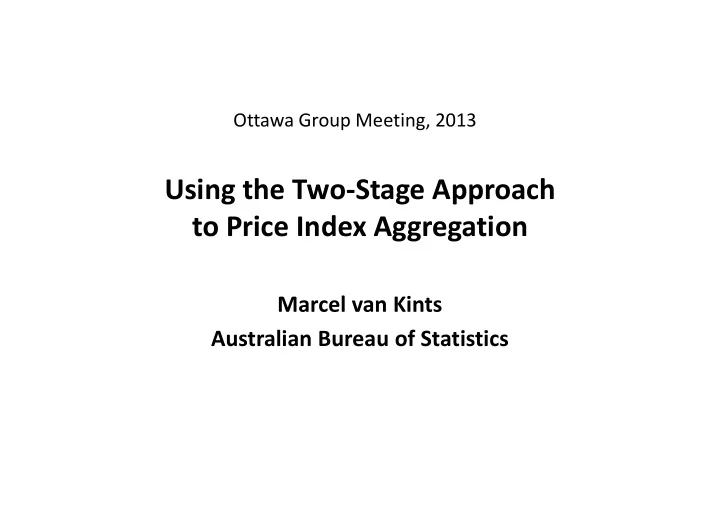

Ottawa Group Meeting, 2013 Using the Two-Stage Approach to Price Index Aggregation Marcel van Kints Australian Bureau of Statistics
Outline of presentation • Background of two-stage approach to price index aggregation. • Methodology. • Practical implications: Sample change and quality adjustment.
Background • Two-stage approach first presented in the IMF’s Price Index Processor Software user guide. http://www.unece.org/fileadmin/DAM/stats/SW_cpi_ppi/CPI_User_Manual_August_2009.pdf • Current ABS practice uses a direct approach to compare current period prices to base period prices. • ABS requirement to update price sample between link periods. • The ABS is considering implementing the two-stage approach for aggregation for all its price indexes.
Two-stage methodology The two-stage approach is represented by a short term price index, which updates a long term price index. Where
Two-stage methodology cont. • Expenditure shares are price updated and rescaled so they sum to 1.
Sample change • Important that sample change does not impact on the measure of price change. • The two-stage approach simplifies the handling of sample change by only requiring data from the previous and current periods. • The addition of items to a price sample must be inserted into the sample so it is equivalent to imputing all previous period prices off the EA movement back until the link period (t=0). • The removal of items from the sample is simply the process of rescaling the expenditure shares so they sum � � 1� . to 1 (∑ � �
Quality change • Key requirement of price indexes is to price to constant quality. • A change in quality over time will mean the raw price index movement will no longer equal the quality adjusted index movement. • Need to quality adjust previous period price. • In order to capture this change, a quality adjusted short term price relative is used.
Practical implications for NSOs • Ability to change weights at the item level may lead to chain drift and loss of transitivity. Proper procedures need to be in place to mitigate this risk. • Revisions must be applied to the period in question and progressively updated in subsequent periods. Clearly defined business processes and system applications are needed to incorporate the use of revisions.
Conclusion • The two-stage approach to aggregation is a robust method of aggregating price values and handling sample change and quality adjustment. • This method simplifies the aggregation process by using a two period view of price observations. • The work by ABS has progressed the intermediate form of the two-stage approach to aggregation to the final practical form.
Recommend
More recommend